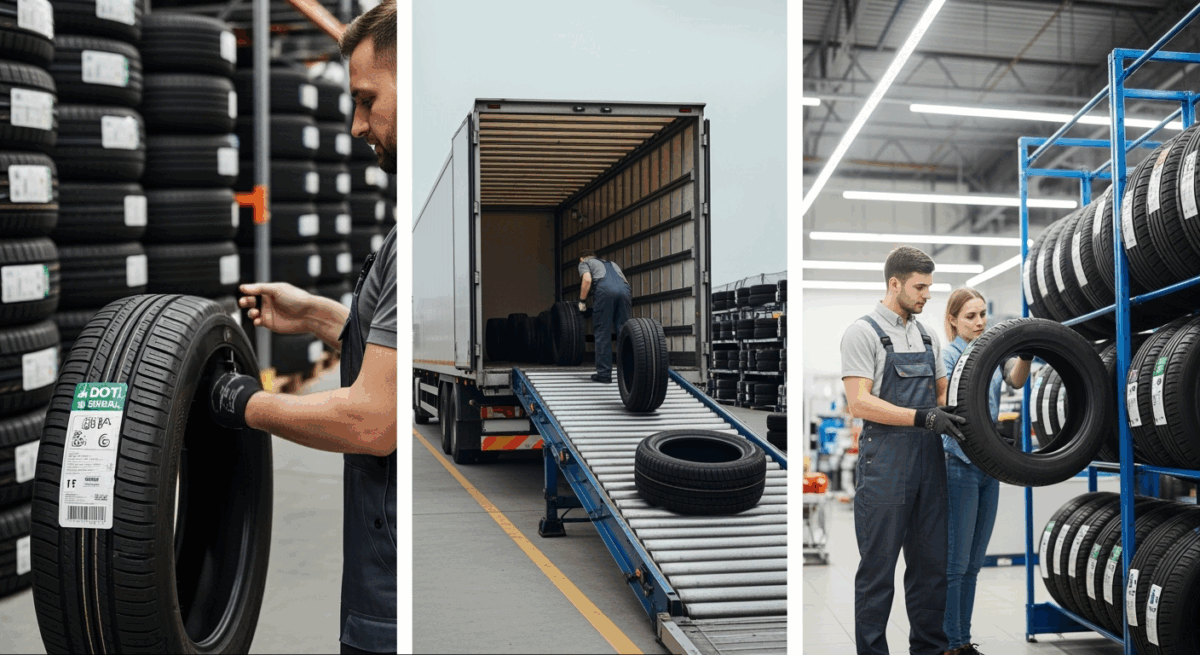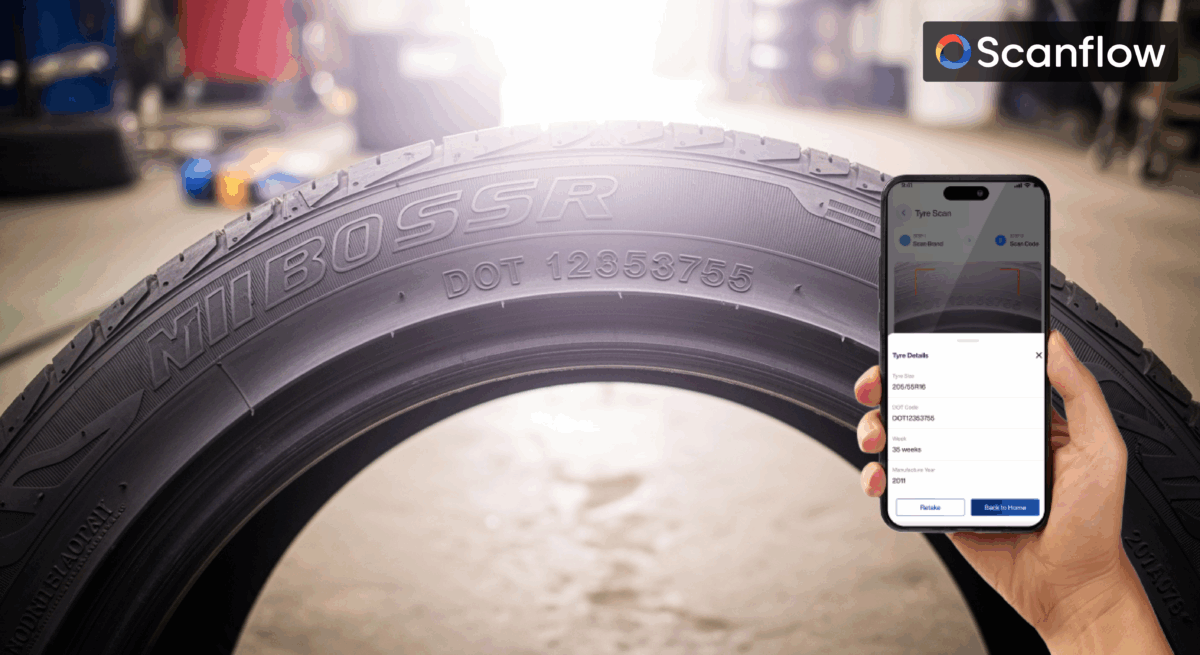Scanflow Tire Sidewall Capture: Deep Technical Insights
Scanflow’s tire sidewall scanning system harnesses mobile edge offline SDK that supports for both ...
5 Mins read
Posted on Oct 13, 2025
August 21, 2025
3 Mins read

Introduction The automotive tyre industry moves millions of units each year across warehouses, retailers, distributors, and service centers. But with such high volume and complex movement, traceability becomes a critical challenge. Tyres often get misplaced, duplicated in records, or lack visibility in their lifecycle, leading to inefficiencies, compliance issues, and financial losses. This is where […]
Introduction
The automotive tyre industry moves millions of units each year across warehouses, retailers, distributors, and service centers. But with such high volume and complex movement, traceability becomes a critical challenge. Tyres often get misplaced, duplicated in records, or lack visibility in their lifecycle, leading to inefficiencies, compliance issues, and financial losses.
This is where AI tyre scanning and digital traceability solutions are transforming how the industry manages tyre movement. By ensuring every tyre is uniquely identifiable and trackable from warehouse shelves to retailer floors businesses gain not only efficiency but also accuracy, safety, and customer trust.
The Challenge of Tyre Movement Without Traceability
For decades, warehouses and retailers have relied on manual processes, barcodes, or spreadsheets to manage tyre stock. While functional, these approaches create problems at scale:
Misplaced Inventory: Tyres move from storage to retailers without accurate logs, creating gaps.
Duplicate Records: Without real-time validation, tyres may appear twice in systems.
Audit Stress: Compliance checks become slow and error-prone without clean traceability.
Lifecycle Blindness: Retailers often lack history of each tyre (production date, usage, warranty).
In industries like automotive, where safety and regulatory compliance are non-negotiable, these gaps can be costly.
Why Traceability Matters in the Automotive Tyre Supply Chain
1. Inventory Accuracy
Every tyre has a unique DOT or serial number. By capturing this at each movement point (warehouse entry, shipment, retail shelf), businesses maintain real-time, error-free inventory records. This reduces discrepancies, prevents overstocking, and eliminates misplacements.
2. Compliance and Audits
Authorities and manufacturers often demand detailed records of tyre origins, conditions, and sales timelines. Digital tyre traceability ensures warehouses and retailers can generate audit-ready reports instantly no scrambling through paper logs.
3. Retail Confidence
For retailers, selling tyres isn’t just about stock it’s about trust. Customers increasingly demand transparency: tyre age, manufacturing details, and usage history. With traceability, retailers can provide this at the point of sale, boosting confidence.
4. Supply Chain Transparency
Traceability creates a connected supply chain. Warehouses know what left their shelves, retailers know what’s arriving, and distributors can monitor flow. This visibility reduces disputes, strengthens vendor relationships, and cuts delays.
5. Lifecycle Management
Traceability doesn’t stop at the sale. With digital history tied to each tyre, businesses can track lifecycle for warranty claims, recalls, and predictive maintenance turning a sale into a long-term customer relationship.
How AI Tyre Scanning Powers Traceability
Traditional methods like barcodes or manual entry aren’t built for tyres. They fail to capture the complexity of DOT markings and serials across tyre brands. AI-powered tyre scanning changes the game.
Instant DOT/Serial Capture: Mobile devices scan and digitize tyre identifiers in seconds.
Error-Free Data Entry: AI eliminates human mistakes from manual typing.
Cloud-Based Records: Every scan updates a central database accessible across warehouses and retailers.
Seamless Integration: Works with existing warehouse or retail apps via SDKs and APIs.
With AI tyre scanning, traceability isn’t an added process it’s embedded into daily operations.
Benefits for Warehouses and Retailers
For Warehouses:
Faster stock reconciliation with AI-driven scans.
Reduced misplacement during inbound/outbound tyre movement.
Easier compliance during inventory audits.
For Retailers:
Real-time visibility of incoming tyre shipments.
Instant access to tyre details for customers (brand, model, age, warranty).
Stronger credibility through transparent sales practices.
Together, this creates a closed-loop system where tyres can be traced from manufacturer → warehouse → retailer → customer, with no blind spots.
The Scanflow Advantage
At Scanflow, we believe tyre traceability should be simple, reliable, and scalable. Our Track and Trace App and AI Tyre Scanning SDK empower automotive businesses to:
Scan DOT/serial numbers instantly with a mobile device.
Maintain a centralized, digital tyre database.
Reduce misplacement, duplication, and audit delays.
Enable complete tyre lifecycle visibility for warehouses, retailers, and fleets.
By turning tyres into digital assets, Scanflow ensures that every movement is traceable, every record is reliable, and every sale is transparent.
Conclusion
In the fast-moving automotive industry, tyre traceability is no longer optional it’s essential. Warehouses need accurate stock records, retailers need customer trust, and the entire supply chain needs transparency.
With AI tyre scanning and digital traceability, businesses can reduce errors, save time, and future proof their operations.
Ready to transform your tyre inventory?
Try Scanflow Track and Trace App for Tyre Management and see how easy tyre traceability can be.
Scanflow Tire Sidewall Capture: Deep Technical Insights
5 Mins read
Posted on Oct 13, 2025
How 3PL Providers Use Mobile Serial Number Scanning to Enhance Traceability
4 Mins read
Posted on Oct 10, 2025

This privacy policy sets out how Scanflow uses and protects any information that you give Scanflow when you use this website. Scanflow is committed to ensuring that your privacy is protected. We shall ask you to provide certain information by which you can be identified when using this website, then you can be assured that it will only be used in accordance with this privacy statement.
Scanflow may change this policy from time to time by updating this page. You should check this page from time to time to ensure that you are happy with any changes.
What We Collect
We may collect the following information:
Name and job title
Contact information including email address
Demographic information such as postcode, preferences and interests
Other information relevant to customer surveys and/or offers
What we do with the information we gather
We require this information to understand your needs and provide you with a better service, and in particular for the following reasons:
Internal record keeping.
We may use the information to improve our products and services.
We may periodically send promotional emails about new products, special offers or other information which we think you may find interesting using the email address which you have provided.
From time to time, we may also use your information to contact you for market research purposes. We may contact you by email, phone, fax or mail.
We may use the information to customize the website according to your interests.
Security
We are committed to ensuring that your information is secure. In order to prevent unauthorized access or disclosure, we have put in place suitable physical, electronic and managerial procedures to safeguard and secure the information we collect online.
How we use cookies
A cookie is a small file which asks permission to be placed on your computer’s hard drive. Once you agree, the file is added and the cookie helps analyze web traffic or lets you know when you visit a particular site. Cookies allow web applications to respond to you as an individual. The web application can tailor its operations to your needs, likes and dislikes by gathering and remembering information about your preferences.
We use traffic log cookies to identify which pages are being used. This helps us analyze data about webpage traffic and improve our website in order to tailor it to customer needs. We only use this information for statistical analysis purposes and then the data is removed from the system.
Overall, cookies help us provide you with a better website, by enabling us to monitor which pages you find useful and which you do not. A cookie in no way gives us access to your computer or any information about you, other than the data you choose to share with us.
You can choose to accept or decline cookies. Most web browsers automatically accept cookies, but you can usually modify your browser setting to decline cookies if you prefer. This may prevent you from taking full advantage of the website.
Links to other websites
Our website may contain links to other websites of interest. However, once you have used these links to leave our site, you should note that we do not have any control over that other website. Therefore, we cannot be responsible for the protection and privacy of any information which you provide whilst visiting such sites and such sites are not governed by this privacy statement. You should exercise caution and look at the privacy statement applicable to the website in question.
Controlling your personal information
You may choose to restrict the collection or use of your personal information in the following ways:
Whenever you are asked to fill in a form on the website, look for the box that you can click to indicate that you do not want the information to be used by anybody for direct marketing purposes
If you have previously agreed to us using your personal information for direct marketing purposes, you may change your mind at any time by writing to or emailing us at info@scanflow.ai We will not sell, distribute or lease your personal information to third parties unless we have your permission or are required by law to do so. We may use your personal information to send you promotional information about third parties which we think you may find interesting if you tell us that you wish this to happen. If you believe that any information, we are holding out from you is incorrect or incomplete, please write to or email us as soon as possible at the above address. We will promptly correct any information found to be incorrect.

